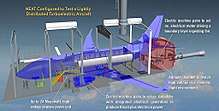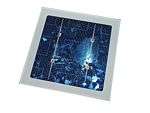Electric aircraft
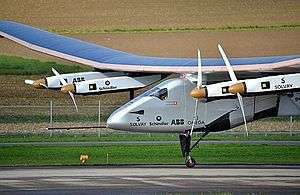
| Part of a series on |
| Aircraft propulsion |
|---|
|
Shaft engines: driving propellers, rotors, ducted fans or propfans |
| Reaction engines |
| Others |
An electric aircraft is an aircraft powered by electric motors. Electricity may be supplied by a variety of methods including batteries, ground power cables, solar cells, ultracapacitors, fuel cells and power beaming.[1]
Electrically powered model aircraft have been flown since the 1970s, with one unconfirmed report as early as 1957.[2][3] They have since developed into small battery-powered unmanned aerial vehicles or drones, which in the twenty-first century have become widely used for many purposes.
Although manned flights in a tethered helicopter go back to 1917 and in airships to the previous century, the first manned free flight by an electrically powered aeroplane was not made until 1973 and most manned electric aircraft today are still only experimental demonstrators.[4] Between 2015 and 2016, Solar Impulse 2 completed a circumnavigation of the Earth.[5]
Design
All electric aircraft to date have been powered by electric motors driving thrust-generating propellers or lift-generating rotors. Some of the propeller-driven types have been airships.
Mechanisms for storing and supplying the necessary electricity vary considerably, and each has distinct advantages and disadvantages. Mechanisms used include:
- Batteries can retain a significant electrical charge, although their weight still limits the range achievable.
- Power cables connect to a ground-based supply.
- Solar cells convert sunlight directly into electricity.
- Ultracapacitors can store a limited amount of energy for short bursts of high-power use
- Fuel cells are similar to batteries but draw their reactants from an external source.
- Microwave energy has been beamed from a ground-based source.
Batteries
Batteries are the most common energy carrier component of electric aircraft, due to their relatively high capacity. Batteries were the earliest source of electricity, first powering airships in the nineteenth century. These early batteries were very heavy and it was not until the arrival of technologies such as nickel-cadmium (NiCad) rechargeable types in the second half of the twentieth century, that batteries became a practicable power source. Modern battery types include lithium-based and a number of other less widely used technologies. Such batteries remain a popular power source today, although they still have limited life between charges and hence limited range.
Batteries are also often used for temporary storage of electricity generated by another source.
Power cables
An electrical power cable may be connected to a ground-based supply, such as an electric generator. At low altitudes this can avoid carrying heavy batteries and was used by the experimental Petróczy-Kármán-Žurovec PKZ-1 observation helicopter of 1917. However such a craft must remain tethered to a ground facility, and the higher it flies, the heavier the weight of cable it must lift with it.
Solar cells
A solar cell converts sunlight directly into electricity, either for direct power or temporary storage. The power output of solar cells is small, even when many are connected together, which limits their use and is also expensive. However their use of freely available sunlight makes them attractive for high-altitude, long-endurance applications.
For endurance flights, keeping the craft in the air all night typically requires a backup storage system, which supplies power during the hours of darkness and recharges during the day.
Ultracapacitors
An ultracapacitor can store a limited amount of energy for short bursts of high-power use, such as when taking off, but due to its relatively small storage ability it is not suitable as a primary power source. Its advantage over a small battery is the ability to charge and discharge much faster with higher peak currents.
Fuel cells
A fuel cell uses the reaction between two fluids such as hydrogen and oxygen to create electricity. Unlike a battery, the fluids are not stored in the battery but are drawn in from outside. This offers the prospect of much greater range than batteries and experimental examples have flown, but the technology has yet to reach production.
Microwaves
Power beaming of electromagnetic energy such as microwaves, like a power cable, requires a ground-based power source. However, compared to a power cable, power beaming carries much less weight penalty as altitude increases. The technology has been demonstrated on small models but awaits practical development.[1]
History
Pioneers
The use of electricity for aircraft propulsion was first experimented with during the development of the airship which took place in the latter part of the nineteenth century. On 8 October 1883, Gaston Tissandier flew the first electrically-powered airship.[6]:292 The following year, Charles Renard and Arthur Krebs flew La France with a more powerful motor.[6]:306 Even with the lifting capacity of an airship, the heavy accumulators needed to store the electricity severely limited the speed and range of such early airships.
For a tethered device such as an air observation platform, it is possible to run the power up the tether. In an attempt to create a more practical solution than the clumsy balloons then in use, the Austro-Hungarian Petróczy-Kármán-Žurovec PKZ-1 electric-powered helicopter was flown in 1917. It had a specially-designed 190 hp (140 kW) continuous-rated electric motor made by Austro-Daimler and received its power up a cable from a ground-based DC generator. However electric motors were not yet powerful enough for such applications and the motor burned out after only a few flights.[7]
In 1909, an electric free flight model was claimed to have been flown eight minutes, but this claim was disputed by the builder of the first recorded electric Radio-Controlled model aircraft flight in 1957.[8] Power density for electric flight is problematic even for small models.
In 1964, William C. Brown at Raytheon flew a model helicopter that received all of the power needed for flight by microwave power transmission.[9]
First prototypes
Success in a full-sized aeroplane would not be achieved until Nickel-cadmium (NiCad) batteries were developed, having a much higher storage-to-weight ratio than older technologies. In 1973, Fred Militky and Heino Brditschka converted a Brditschka HB-3 motor glider to an electric aircraft, the Militky MB-E1. It flew for just 14 minutes to become the first manned electric aircraft to fly under its own power.[4][10]
Developed almost in parallel with NiCad technology, solar cells were also slowly becoming a practicable power source. Following a successful model test in 1974, the world’s first official flight in a solar-powered, man-carrying aircraft took place on April 29, 1979. The Mauro Solar Riser used photovoltaic cells to deliver 350 watts at 30 volts. These charged a small battery, which in turn powered the motor. The battery alone was capable of powering the motor for 3 to 5 minutes, following a 1.5-hour charge, enabling it to reach a gliding altitude.[11]
Under the direction of Freddie To, an architect and member of the Kremer prize committee, the Solar One was designed by David Williams and produced by Solar-Powered Aircraft Developments. A motor-glider type aircraft originally built as a pedal-powered airplane to attempt the Channel crossing, the airplane proved too heavy to be successfully powered by human power and was then converted to solar power,[12] using an electric motor driven by batteries that were charged before flight by a solar cell array on the wing.[13] The maiden flight of Solar One took place at Lasham Airfield, Hampshire, on June 13, 1979.[14]
Following successful human-powered flight, a relaunched Kremer prize allowed the crew to store energy before takeoff.[15] In the 1980s several such designs stored electricity generated by pedalling, including the Massachusetts Institute of Technology Monarch and the Aerovironment Bionic Bat.[16]
The human piloted Solair 1, developed by Günther Rochelt, flew in 1983 with notably improved performance.[2][17] It employed 2499 wing-mounted solar cells.[2]
The German solar-powered aircraft "Icaré II" was designed and built by the institute of aircraft design (Institut für Flugzeugbau) of the University of Stuttgart in 1996. The leader of the project and often pilot of the aircraft is Rudolf Voit-Nitschmann the head of the institute. The design won the Berblinger prize in 1996, the EAA Special Achievement Award in Oshkosh, the Golden Daidalos Medal of the German Aeroclub and the OSTIV-Prize in France in 1997.[18]
Unmanned aerial vehicles
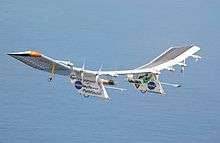
NASA's Pathfinder, Pathfinder Plus, Centurion, and Helios were a series of solar and fuel cell system–powered unmanned aerial vehicles (UAVs) developed by AeroVironment, Inc. from 1983 until 2003 under NASA's Environmental Research Aircraft and Sensor Technology program.[19][20] On September 11, 1995, Pathfinder set an unofficial altitude record for solar-powered aircraft of 50,000 feet (15,000 m) during a 12-hour flight from NASA Dryden.[19] After further modifications, the aircraft was moved to the U.S. Navy's Pacific Missile Range Facility (PMRF) on the Hawaiian island of Kauai. On July 7, 1997, Pathfinder raised the altitude record for solar–powered aircraft to 71,530 feet (21,800 m), which was also the record for propeller–driven aircraft.[19]
On August 6, 1998, Pathfinder Plus raised the national altitude record to 80,201 feet (24,445 m) for solar-powered and propeller-driven aircraft.[19][21]
On August 14, 2001 Helios set an altitude record of 96,863 feet (29,524 m) – the record for FAI class U (experimental/new technologies), and FAI class U-1.d (remotely controlled UAV: mass 500 kg to less than 2,500 kg) as well as the altitude record for propeller–driven aircraft.[22] On June 26, 2003, the Helios prototype broke up and fell into the Pacific Ocean off Hawaii after the aircraft encountered turbulence, ending the program.
The QinetiQ Zephyr is a lightweight solar-powered unmanned aerial vehicle (UAV). As of 23 July 2010 it holds the endurance record for an unmanned aerial vehicle of over 2 weeks (336 hours).[23] It is of carbon fiber-reinforced polymer construction, the 2010 version weighing 50 kg (110 lb)[24] (the 2008 version weighed 30 kg (66 lb)) with a span of 22.5 metres[24] (the 2008 version had 18 metres (59 feet)). During the day it uses sunlight to charge lithium-sulphur batteries, which power the aircraft at night.[25] In July 2010 a Zephyr made a world record UAV endurance flight of 336 hours, 22 minutes and 8 seconds (more than two weeks) and also set an altitude record of 70,742 feet (21,562 m) for FAI class U-1.c (remotely controlled UAV: weight 50 kg to less than 500 kg).[26][27][28]
Light aircraft
The first commercially available, non-certified production electric aircraft, the Alisport Silent Club self-launching glider plane, flew in 1997. It is optionally driven by a 13 kW (17 hp) DC electric motor running on 40 kg (88 lb) of batteries that store 1.4 kWh of energy.[29]
The first certificate of airworthiness for an electric powered aircraft was granted to the Lange Antares 20E in 2003. Also an electric, self-launching 20-meter glider/sailplane, with a 42-kilowatt DC/DC brushless motor and lithium-ion batteries, it can climb up to 3,000 meters with fully charged cells.[30] The first flight was in 2003. In 2011 the aircraft won the 2011 Berblinger competition.[31]
In 2005, Alan Cocconi of AC Propulsion flew, with the assistance of several other pilots, an unmanned airplane named "SoLong" for 48 hours non-stop, propelled entirely by solar energy. This was the first such around-the-clock flight, on energy stored in the batteries mounted on the plane.[32][33]
In 2007, the non-profit CAFE Foundation held the first Electric Aircraft Symposium in San Francisco.[34]
The Boeing-led FCD (fuel cell demonstrator) project uses a Diamond HK-36 Super Dimona motor glider as a research test bed for a hydrogen fuel cell powered light airplane.[35] Successful flights took place in February and March 2008.[35][36]
The first the NASA Green Flight Challenge took place in 2011 and was won by a Pipistrel Taurus G4 on 3 October 2011.[37][38][39]
In 2013 Chip Yates demonstrated that the world's fastest electric plane, a Long ESA, a modified Rutan Long-EZ, could outperform a gasoline-powered Cessna and other aircraft in a series of trials verified by the Fédération Aéronautique Internationale. The Long ESA was found to be less expensive, have a higher maximum speed, and higher rate of climb, partly due to the ability of the aircraft to maintain performance at altitude as no combustion takes place.[40][41]
In 2017, Siemens used a modified Extra EA-300 acrobatic airplane, the 330LE, to set two new records: on March 23 at the Dinslaken Schwarze Heide airfield in Germany, the aircraft reached a top speed of around 340 km/h (180 kn) over three kilometers; the next day, it became the first glider towing electric aircraft.[42]
Solar Impulse circumnavigation
Solar Impulse 2 is powered by four electric motors. Energy from solar cells on the wings and horizontal stabilizer is stored in lithium polymer batteries and used to drive propellers.[43][44] In 2012 the first Solar Impulse made the first intercontinental flight by a solar plane, flying from Madrid, Spain to Rabat, Morocco.[45][46]
Completed in 2014, Solar Impulse 2 carried more solar cells and more powerful engines, among other improvements. In March 2015, the plane took off on the first stage of a planned round-the-world trip, flying Eastwards from Abu Dhabi, United Arab Emirates.[5] Due to battery damage, the craft halted at Hawaii until April 2016.[47] On 23 June 2016 the plane reached Seville, Spain.[48] It has since returned to Abu Dhabi, completing its circumnavigation of the world.[49]
Developments
.jpg)
The NASA Puffin was a concept, proposed in 2010, for an electric-powered, vertical takeoff and landing (VTOL), personal air vehicle.[50]
The European Commission has financed many low TRL projects for innovative electric or hybrid propulsion aircraft. The ENFICA-FC is a project of the European Commission, to study and demonstrate an all-electric aircraft with fuel-cells as the main or auxiliary power system. During the three-year project, a fuel-cell based power system was designed and flown in a Rapid 200FC ultralight aircraft.[51]
The NASA Electric Aircraft Testbed (NEAT) is a NASA reconfigurable testbed in Plum Brook Station, Ohio, used to design, develop, assemble and test electric aircraft power systems, from a small, one or two person aircraft up to 20 MW (27,000 hp) airliners.[52] NASA research agreements (NRA) are granted to develop electric-propulsion components. They will be completed in 2019 and the internal NASA work by 2020, then they will be assembled in a megawatt-scale drive system to be tested in the narrowbody-sized NEAT.[53]
NASA developed the X-57 Maxwell to demonstrate technology to reduce fuel use, emissions, and noise.[54] Modified from a Tecnam P2006T, the X-57 will have 14 electric motors driving propellers mounted on the wing leading edges.[55] In July 2017, Scaled Composites is modifying a first P2006T by replacing the piston engines with electric motors, to fly early in 2018, then will move the motors to the wingtips to increase propulsive efficiency and finally will instal of the high aspect ratio wing with 12 smaller props.[56]
In September 2017, UK budget carrier EasyJet announced it was developing an electric 180-seater for 2027 with Wright Electric.[57] Founded in 2016, US Wright Electric did built a two-seat proof-of-concept with 272 kg (600 lb) of batteries, and believes they can be scaled up with substantially lighter new battery chemistries: a 291 nm (540 km) range would suffice for 20% of Easyjet passengers.[58] Wright Electric will then develop a 10-seater, eventually an at least 120 passengers single aisle, short haul airliner and targets 50% lower noise and 10% lower costs.[59]
On March 19, 2018, Israel Aerospace Industries announced it plans to develop a short-haul electric airliner, building on its small UAS electric power systems experience. It could develop it in-house, or with a startup like Israeli Eviation, U.S. Zunum Aero or Wright Electric.[60]
Australia-based MagniX intends to fly an electric Cessna 208 Caravan with a 540 kW (720 hp) motor for up to an hour, by August 2019. The company's Magni5 electric motor already produces continuously 265–300 kW (355–402 hp) peak at 2,500 rpm at 95% efficiency with a 53 kg (117 lb.) dry mass, a 5 kW/kg power density, competing with the 260 kW (350 hp), 50 kg (110 lb) Siemens SP260D for the Extra 330LE.[61] By September 2018, a 350 hp (260 kW) electric motor with a propeller had been tested on a Cessna iron bird. The 750 hp (560 kW) Caravan was expected to fly by the fall of 2019 and by 2022 MagniX estimates electric aircraft will fly up to 500 and 1,000 mi (800 and 1,610 km) by 2024.[62] The motor ran on a test dynamometer for 1,000 hours. The iron bird is a Caravan forward fuselage used as a test bed, with the usual PT6 turboprop engine replaced by an electric motor, inverter and a liquid-cooling system, including radiators, driving a Cessna 206 propeller. The production motor will produce 280 kW (380 hp) at 1,900 rpm, down from the test motor's 2,500 rpm, allowing the installation of the propeller without a reduction gearbox.[63]
Hybrid power
Zunum Aero, backed by Boeing and JetBlue, is working since 2013 on a family of 10- to 50-seat hybrid electric regional aircraft.[64] On 5 October 2017, Zunum launched the development of a six-to-12-seat aircraft with its powertrain installed on a testbed and flown in 2019. Aiming to fly in 2020 and be delivered in 2022, it should lower operating costs by 40–80% to reach available seat miles (ASM) costs of a 78-seat Dash 8-Q400.[65]
On 28 November 2017, Airbus announced a partnership with Rolls-Royce plc and Siemens to develop the E-Fan X hybrid-electric airliner demonstrator, to fly in 2020.[66]
The 1,300-shp GE Catalyst could be used in hybrid-electric propulsion: in late 2016, General Electric modified a GE F110 fighter turbofan to extract 250 kW from its HP turbine and 750 kW from its LP turbine, supported by the USAF Research Laboratory and NASA, developed and tested a 1-megawatt electric motor/generator with GE Global Research, and tested a liquid-cooled inverter converting 2,400-volt DC to three-phase AC with silicon carbide-based switches and 1.7-kW MOSFET power modules.[67]
By May 2018, consulting firm Roland Berger counted almost 100 electric aircraft in development.[68] This was up from 70 the previous year and included 60% from startups, 32% from aerospace incumbents, half of them major OEMs and 8% from academic, government organizations and non-aerospace companies, mainly from Europe (45%) and the U.S. (40%). Mostly urban air taxis (50%) and general aviation aircraft (47%), a majority are battery-powered (73%), while some are hybrid-electric (31%), mostly larger airliners. Industry experts expects a 50+ seat hybrid-electric airliner to debut in commercial operation by 2032 for routes like London-Paris.[69]
The potential of electric and hybrid-electric propulsion remains limited for general aviation, according to Textron Aviation, as the specific energy of electricity storage is still 2% of aviation fuel.[70] An hybrid configuration is needed for airliners: lithium-ion batteries including packaging and accessories gives 160 Wh/kg while aviation fuel gives 12,500 Wh/kg.[71] As electric machines and converters are more efficient, their shaft power available is closer to 145 Wh/kg of battery while a gas turbine gives 6,545 Wh/kg of fuel: a 45:1 ratio.[72]
The EU funded the Hypstair program with €6.55 million over three years till 2016 for a TRL of 4: a Pipistrel Panthera mockup received a serial hybrid-electric powertrain, ground testing a 200-kW motor driven by batteries only, by a 100-kW generator-only and by both combined. It is followed by Mahepa project from 2017, EU-funded over four years with €9 million under the Horizon 2020 research program to reduce aviation carbon emissions by 70% in 2050, till TRL 6 before entering product development. The Panthera drivetrain will be divided in modules: electric motor thrust generator and internal combustion power generator in the nose, human-machine interface and computing, fuel and batteries in the wing. Ground testing is planned for 2019 before flight tests in 2020.[73]
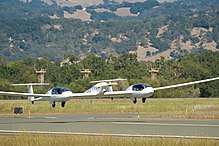
The dual-fuselage, four-seat, battery-powered Pipistrel Taurus G4 received a DLR hydrogen fuel cell powertrain to fly as the HY4 in September 2016, with hydrogen tanks and batteries in the fuselages, fuel cells and motor in the central nacelle. Partners are German motor and inverter developer Compact Dynamics, Ulm University, TU Delft, Politecnico di Milano and University of Maribor. Ground and flight tests should follow those of the Panthera a couple of months later.[73]
Along their ground handling, scaling to 19- and 70-seat airliners will be studied in two configurations: more of the same size modules for electric distributed propulsion, or larger sized modules extrapolating the flight-test results, powering twin propellers. Flights will test system behavior, measure performance and reliability, and evaluate failure modes. A failure rate of one per 10 million hours is targeted, as low as in airliners, with very reliable components or with redundancy.[73]
Applications
Currently, battery-powered electric aircraft have much more limited payload, range and endurance than those powered by internal combustion engines. However, pilot training is an area that emphasises short flights. Several companies make, or have demonstrated, light aircraft suitable for initial flight training. The Airbus E-Fan was aimed at flight training but the project was cancelled. Pipistrel makes light sport electric aircraft such as the Pipistrel WATTsUP. A prototype of the Aero Electric Sun Flyer. The advantage of electric aircraft for flight training is the lower cost of electrical energy compared to aviation fuel. Noise and exhaust emissions are also reduced compared with combustion engines.
Electric rotorcraft
Although the Austro-Hungarian Petróczy-Kármán-Žurovec team flew an experimental tethered military observation helicopter in 1917, the use of electric power for rotor-borne flight was not exploited until modern times.
Unmanned
Lightweight components have enabled the development, for recreational purposes among others, of small, cheap radio-controlled unmanned aerial vehicles, often called drones, notably the widespread quadcopter.
Manned
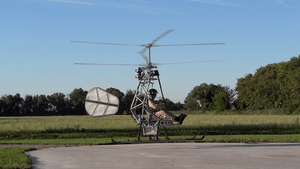
The Solution F/Chretien Helicopter the world's first man-carrying, free-flying electric helicopter was developed by Pascal Chretien. The concept was taken from the conceptual computer-aided design model on September 10, 2010 to the first testing at 30% power on March 1, 2011—less than six months. The aircraft first flew August 4 to 12, 2011. All development was conducted in Venelles, France.[74][75]
In February 2016, Philippe Antoine, AQUINEA and ENAC, Ecole Nationale Supérieure de l'Aviation Civile, successfully flew the first full electric conventional helicopter called Volta in Castelnaudary Airfield, France. Volta demonstrated a 15-minute hovering flight in December 2016. The helicopter is powered by two PMSM motors delivering together 80 kW and a 22kWh Lithium battery. Volta is officially registered by DGAC, the French Airworthiness Authority, and is authorized for flying in the French civilian airspace.
In September 2016, Martine Rothblatt and Tier1 Engineering successfully tested an electric-powered helicopter. The five minute flight reached an altitude of 400 feet with a peak speed of 80 knots. The Robinson R44 helicopter was modified with two three-phase permanent magnet synchronous YASA Motors, weighing 100 lb, plus 11 Brammo Lithium polymer batteries weighing 1100 lb and a digital cockpit display.[76][77][78] It later flew for 20 minutes in 2016.[79][80]
Projects
The Sikorsky Firefly S-300 was a project to flight test an electric rotorcraft, but the project was put on hold due to battery limitations.[81] The world's first large-scale all-electric tilt-rotor was the AgustaWestland Project Zero unmanned aerial vehicle technology demonstrator, which performed unmanned tethered fights on ground power in June 2011, less than six months after the company gave the official go-ahead.[82]
The Airbus CityAirbus is an electrically-powered VTOL aircraft demonstrator. The multirotor aircraft is intended to carry four passengers, with a pilot initially and to become self-piloted when regulations allow.[83] Its first unmanned flight is scheduled for the end of 2018 with manned flights following in 2019.[84] Type certification and commercial introduction are planned for 2023.[85]
See also
References
- 1 2 Power Beaming Archived February 17, 2013, at the Wayback Machine.
- 1 2 3 Noth, André (July 2008). "History of Solar Flight" (PDF). Autonomous Systems Lab. Zürich: Swiss Federal Institute of Technology. p. 3. Archived from the original (PDF) on 2012-02-01. Retrieved 8 July 2010.
Günter Rochelt was the designer and builder of Solair I, a 16 m wingspan solar airplane ... 21st of August 1983 he flew in Solair I, mostly on solar energy and also thermals, during 5 hours 41 minutes.
- ↑ "Infographic: A Timeline Of The Present And Future Of Electric Flight". Popular Science. Retrieved 7 January 2016.
- 1 2 Taylor, John W R (1974). Jane's All the World's Aircraft 1974–75. London: Jane's Yearbooks. p. 573. ISBN 0 354 00502 2.
- 1 2 Batrawy, Aya (9 March 2015). "Solar-powered plane takes off for flight around the world". Associated Press. Retrieved 14 March 2015.
- 1 2 Gaston Tissandier (1886). La Navigation aérienne (in French). Hachette. L'aviation et la direction des aérostats.
- ↑ Grosz, P. (1978). "Helicopter pioneers of World War I". Air Enthusiast. No. 6. pp. 154–159.
- ↑ Dave Day (1983). "History of Electric Flight". Electric Flight. Argus Books.
- ↑ Arthur Fisher (January 1988). "Microwave power transmission: a brief history". Popular Science. No. 232. p. 65.
- ↑ "fuel cost – flight international – fuel price – 1973 – 2937 – Flight Archive". flightglobal.com. Retrieved 8 December 2015.
- ↑ Experimental Aircraft Association, Inc. (2008). "UFM/MAURO SOLAR RISER". Retrieved 2008-06-27.
- ↑ AIAA/SAE/ASME 20th Joint Propulsion Conference (1984). "AIAA paper 84-1429" (PDF). Archived from the original (PDF) on 2011-07-07. Retrieved 2011-03-04.
- ↑ Solar Challenger (1980). "Solar Challenger" (PDF). Retrieved 2011-03-04.
- ↑ Flightglobal Archive (1979). "UK's first solar aircraft takes off". Retrieved 2011-03-04.
- ↑ Flight, 16 March 1985
- ↑ Bionic Bat – Stored energy human powered aircraft M. Cowley, AeroVironment, Inc., Simi Valley, CA; W. MORGAN, AeroVironment, Inc., Simi Valley, CA; P. MACCREADY, AeroVironment, Inc., Monrovia, CA Chapter DOI: 10.2514/6.1985-1447 Publication Date: 8 July 1985 – 11 July 1985
- ↑ Khammas, Achmed A. W. (2007). "Elektro- und Solarflugzeuge (1960–1996)". Buch der Synergie (in German). Retrieved 8 July 2010.
exakt 2.499 Solarzellen ausgestattet, die eine Leistung von 2,2 kW
- ↑ Institut für Flugzeugbau (November 2009). "Icaré this year was in top form". Retrieved 13 June 2011.
- 1 2 3 4 "NASA Armstrong Fact Sheet: Helios Prototype". NASA. Retrieved 8 December 2015.
- ↑ Goebel, Greg, "The Prehistory of Endurance UAVs", Unmanned Aerial Vehicles, chapter 12. Exists in the public domain. Archived July 30, 2013, at the Wayback Machine.
- ↑ "Page Not Found". naa.aero. Archived from the original on 12 February 2012. Retrieved 8 December 2015.
- ↑ "Aviation and Space World Records". Fédération Aéronautique Internationale. Retrieved 14 October 2013.
- ↑ Amos, Jonathan (2010-07-23). "'Eternal plane' returns to Earth". BBC News. Retrieved 2010-07-23.
touched down at 1504 BST ... on Friday ... took off ... at 1440 BST (0640 local time) on Friday, 9 July
- 1 2 Amos, Jonathan (2010-07-17). "Zephyr solar plane flies 7 days non-stop". BBC News. Retrieved 2010-07-17.
- ↑ QinetiQ Group PLC (n.d.). "Zephyr – QinetiQ High-Altitude Long-Endurance (HALE) Unmanned Aerial Vehicle (UAV)". Retrieved 2008-09-14.
- ↑ Amos, Jonathan (2008-08-24). "Solar plane makes record flight". BBC News. Retrieved 2008-08-25.
- ↑ Grady, Mary (December 2010). "Solar Drone Sets Endurance Record". AvWeb. Retrieved 30 December 2010.
- ↑ "Aviation and Space World Records". Fédération Aéronautique Internationale. Retrieved 14 October 2013.
- ↑ AliSport (n.d.). "Silent Club > Electric Self-launch Sailplane". Archived from the original on 2009-04-20. Retrieved 2009-11-04.
- ↑ 06.09.2011: SWR.de The Research Aircraft Antares DLR H2 and Antares H3 Archived 2006-08-12 at the Wayback Machine.
- ↑ "2011 Berblinger competition".
- ↑ Solar Impulse website, Solar Aviation History Archived 2011-06-28 at the Wayback Machine.
- ↑ Solar Plane Breaks Two-Night Flight Barrier Renewable Energy World, July 5, 2005
- ↑ "Electric Aircraft". cafefoundation.org. Retrieved 8 December 2015.
- 1 2 Niles, Russ (April 2008). "Boeing Flies Fuel Cell Aircraft". Retrieved 2008-05-13.
- ↑ David Robertson (2008-04-03). "Boeing tests first hydrogen powered plane". London: The Times.
- ↑ Pew, Glenn (July 2011). "Taurus G4 Aims For 400 Passenger Miles Per Gallon". AVweb. Retrieved 14 July 2011.
- ↑ Niles, Russ (August 2011). "Four-Place Electric Airplane Flies". AVweb. Retrieved 15 August 2011.
- ↑ Grady, Mary (September 2011). "NASA Awards $1.35 Million For Efficient Flight". AVweb. Retrieved 5 October 2011.
- ↑ Paur, Jason. "Chip Yates Sets 5 New Electric Plane World Records in 4 Weeks". WIRED. Retrieved 2017-03-22.
- ↑ Davies, Alex. "This Record-Breaking Electric Plane Stomps a Gas-Powered Cessna". WIRED. Retrieved 2017-03-22.
- ↑ "World-record electric motor for aircraft" (Press release). Siemens. 20 June 2017.
- ↑ Grady, Mary (June 2009). "Solar Impulse Unveiling Set For Friday". Retrieved 2009-06-25.
- ↑ Pew, Glenn (June 2009). "Solar Impulse Is Revealed". Retrieved 2009-06-29.
- ↑ "Solar plane completes maiden intercontinental trip". Reuters. 5 June 2012. Retrieved 6 June 2012.
- ↑ "Solar Impulse Completes World Record Flight from Spain to Morocco". CleanTechnica. 6 June 2012. Retrieved 7 June 2012.
- ↑ Amos, Jonathan. "Solar Impulse grounded until 2016", BBC News, 15 July 2015
- ↑ "The Atlantic Crossing is completed!". Solar Impulse. Retrieved 27 September 2017.
- ↑ Carrington, Damian (July 26, 2016). "Solar plane makes history after completing round-the-world trip". The Guardian. Retrieved 22 May 2017.
- ↑ NASA's Puffin Is a Stealthy, Personal Tilt-Rotor Aircraft, Clay Dillow, Popular Science, 2010-01-19.
- ↑ Politecnico di Torino. "ENFICA-FC – ENvironmentally Friendly Inter City Aircraft powered by Fuel Cells". polito.it. Retrieved 8 December 2015.
- ↑ Deborah Lockhart (Oct 17, 2016). "It's Electric! NASA Glenn Engineers Test Next Revolution Aircraft". NASA Glenn Research Center.
- ↑ Graham Warwick (Aug 25, 2017). "NASA Moves Electric-Propulsion Components Closer To Reality". Aviation Week & Space Technology.
- ↑ Allard Beutel (2016-06-17). "NASA Electric Research Plane Gets X Number, New Name". NASA.
- ↑ Button, Keith (May 2016). "Flying on Electrons (p.26 of March 2016 issue)". Aerospace America. American Institute of Aeronautics and Astronautics.
- ↑ Graham Warwick (Jul 19, 2017). "NASA Pushing Ahead With Electric X-plane". Aviation Week Network.
- ↑ Victoria Moores (Sep 27, 2017). "EasyJet joins electric aircraft project". Aviation Week Network.
- ↑ Dominic Perry (27 September 2017). "EasyJet unveils short-haul electric aircraft ambition". Flightglobal.
- ↑ Monaghan, Angela (27 September 2017). "EasyJet says it could be flying electric planes within a decade". The Guardian. Retrieved 28 September 2017.
- ↑ Graham Warwick (Mar 26, 2018). "The Week in Technology, March 26-30, 2018". Aviation Week & Space Technology.
- ↑ Michael Bruno (Jun 7, 2018). "MagniX Promises Electrically Powered Cessna Caravan By Summer 2019". Aviation Week & Space Technology.
- ↑ Alexa Rexroth (September 27, 2018). "MagniX Reaches Milestone on Path to Electric Propulsion". AIN online.
- ↑ Graham Warwick (Sep 28, 2018). "MagniX Advances Electric Propulsion System Tests". Aviation Week & Space Technology.
- ↑ Graham Warwick (Apr 5, 2017). "Boeing, JetBlue Back Hybrid-Electric Regional Startup". Aviation Week & Space Technology.
- ↑ Stephen Trimble (Oct 5, 2017). "Zunum launches hybrid-electric aircraft for regional market". Flightglobal.
- ↑ "Airbus, Rolls-Royce, and Siemens team up for electric future" (PDF) (Press release). Airbus, Rolls-Royce, Siemens. 28 Nov 2017. (Airbus, Rolls-Royce, Siemens)
- ↑ Guy Norris (May 23, 2018). "GE's Catalyst Could Lead Way To Hybrid-Electric Power". Aviation Week & Space Technology.
- ↑ Robert Thomson (2018-05-23). "Electric propulsion is finally on the map". Roland Berger.
- ↑ Michael Bruno (Aug 24, 2018). "Aerospace Sector Could See Overhaul From Electric Propulsion". Aviation Week & Space Technology.
- ↑ Stephen Trimble (28 May 2018). "Cessna short-circuits talk of electric-powered aircraft". Flightglobal.
- ↑ Philip E. Ross (1 Jun 2018). "Hybrid Electric Airliners Will Cut Emissions—and Noise". IEEE Spectrum.
- ↑ Bjorn Fehrm (June 30, 2017). "Bjorn's Corner: Electric aircraft". Leeham.
- 1 2 3 Graham Warwick (Aug 7, 2018). "European Project To Benchmark Hybrid-Electric Propulsion". Aviation Week & Space Technology.
- ↑ "Challenges of Aircraft Hybridization". IDTechEx. Retrieved 2013-04-29.
- ↑ "Vertiflite, March/April 2012 – AHS Online Store". Vtol.org. Retrieved 2013-04-28.
- ↑ Grady, Mary (October 17, 2016). "First Flight For Battery-Powered Helicopter". AVweb.com. Retrieved October 21, 2016.
- ↑ Bradley Zint (October 7, 2016). "Costa Mesa firm tests first manned battery-powered chopper". LA Times. Retrieved October 21, 2016.
- ↑ "Watch the World's First Manned Battery-Powered Helicopter Fly". Fortune. October 31, 2016. Retrieved November 4, 2016.
- ↑ "The first battery-powered manned helicopter: 20 minutes flight time with 1100 lbs battery pack". Electrek. 5 October 2016. Retrieved 6 October 2016.
- ↑ Video on YouTube
- ↑ Project Firefly
- ↑ "AHS – Sample Vertiflite article: Project Zero". Vtol.org. 2013-03-04. Retrieved 2013-04-28.
- ↑ "CityAirbus Backgrounder" (PDF). Airbus. June 2017.
- ↑ Dominic Perry (20 Dec 2017). "Airbus Helicopters powers up CityAirbus 'iron bird' rig". Flightglobal.
- ↑ "CityAirbus demonstrator passes major propulsion testing milestone" (Press release). Airbus. 3 October 2017.
External links
| Wikimedia Commons has media related to Electrically powered aircraft. |
- André Noth (Sep 2008). Design of Solar Powered Airplanes for Continuous Flight (PDF) (Thesis). ETH Zurich.
- Dean Kontinos, John Melton, Shon Grabbe, Juan Alonso, Jeff Sinsay, Brendan Tracey (5 June 2012). "Combined Electric Aircraft and Airspace Management Design for Metro-Regional Public Transportation" (PDF). NASA.
- Paul Bertorelli (February 18, 2016). "The Electric Airplane Performance Dip". AVweb.
- Peter Bjarnholt (Aug 2016). Electric Propulsion in Passenger Jet Airplanes (PDF) (Thesis). KTH School of Industrial Engineering and Management.
- "Aircraft Electrical Propulsion – The Next Chapter of Aviation?" (PDF). Roland Berger Strategy Consultants. September 2017.
- Ralph H. Jansen; et al. (2017). "Overview of NASA Electrified Aircraft Propulsion Research for Large Subsonic Transports" (PDF). NASA Glenn Research Center.
- John Morris (Jul 31, 2018). "EAA AirVenture Fuels Debate Over Electric Flight". Aviation Week & Space Technology.
